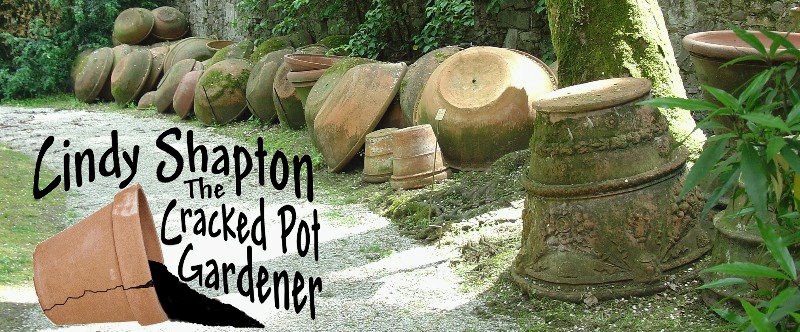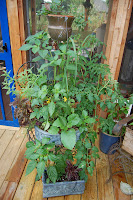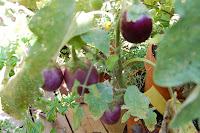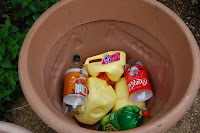Love to garden but don’t have a big yard, or lots of extra time? Pot gardening may be just the ticket for you. It allows you the opportunity to have a beautiful garden in a small area, without having to spend a vacation day or your entire weekend to accomplish! All you need is a few pointers and your own natural creativity to get you on the road to pot gardening.
First you will need a pot. Pot being a relative term for any kind of container that has enough room for potting soil, plants, holes for drainage and can fit somewhere on your porch, deck or patio. Have a blast with this one...go to the antique or junk store, garage sales or even better look through your garage or attic. You will be amazed what you will find to use for planters! I have been known to use old chairs, bird houses, antique bed pans, large funnels, bird baths, old pots and pans, granite dishpans, buckets, baskets and my all time favorite, my sons’ work boots (of course they were size 14 and 15 – who could resist?) Of course conventional clay or lightweight plastic pots are wonderful as well and might be more appropriate for a front entrance.
Most vegetables, herbs and flowers love at least 6 hours of sun each day. For convenience sake locate your containers near the kitchen where you can run and quickly pick or snip fresh produce when you need it. A water source nearby is a good idea saving you time and frustration as you will need to water plants more often in a pot, especially during hot summers. Water as needed...being careful to avoid extremes of dry and wet...usually once in the morning. Form a habit of watering while you drink your morning brew...one more exciting reason to jump out of bed.
It is nice to pick a mixture of plants using various colors, shapes, and textures. . When it comes to design think outside the pot, anything goes. However, if that concept is scary, try the following basic formula:
Vertical interest: Choose a plant that is tall or a trellis for the center of the container, a real show stopper.
Mid-section: Use plants with lots of texture, blooms and foliage, fill it
out!
Bottom fall out: Plants with natural drooping tendencies go around the
edge, cascading down the sides as they grow.
In other words, you will need a thriller, fillers and spillers! Use transplants or plant seeds. The great thing about kitchen pots is that you can start in early spring with cool season veggies when the average daytime temperature is 60 degrees and nights average 40 degrees. As the weather warms to 70 -80 degrees with nights above 50 degrees you can switch to warm season crops. In many areas you can then start cool season veggies again in late summer for fall produce. With a little protection from freezing nights, some may be able to pot garden most of the year.
If your containers are large you can do what I do and recycle some plastic milk jugs, soda bottles and water bottles in the bottom before filling up with soil. This makes the container much easier to move around and less expensive. The roots need about 8 – 12 inches. Use potting soil, or compost or a mixture of top soil, peat moss, potting soil, compost, vermiculite.
Plant what you like to eat and try a few new things just for fun. Try theme gardening by planting a salsa garden with tomato, cilantro, green onions and hot peppers, or an Italian garden with tomato, eggplant, basil, garlic chives, marjoram and oregano.
Keep in mind companion planting; sweet alyssum to house beneficial insects or basil with tomatoes for improved vigor and flavor and to confuse those nasty hornworms. These are just two examples – pick up a copy of my book “The Cracked Pot Herb Book” for more companion ideas.
Here are some plant ideas for your kitchen pots – just to get you thinking…
Warm Season:
Thrillers – Lemon grass, okra, scarlet runner or pole beans on a trellis.
Fillers – Tomatoes, basil, eggplant, peppers, parsley, oregano, chives,
Spillers – thyme, alyssum, pinks, golden oregano
Cool Season:
Thrillers – Peas on a trellis, cilantro
Fillers – Kale, beets, lettuce, radish, chard, broccoli raab, arugula
Spillers, pinks, thyme, parsley
Fertilize if needed when you plant with a slow release variety granular (made for vegetables) for up to three months of worry free growth. Or add composted horse, cow or chicken manure each time you start a new crop. A compost tea can be used as well for a plant “pick-me-up” during the growing season if needed.
Look for vegetable, herbs and flowers developed with container growing in mind.
This year I'm growing plants for my kitchen garden pots from Renee's Garden
container collection -'Pizza My Heart' peppers, 'Super Bush' tomato, 'Little prince'
eggplant, 'Bush Slicer' cucumber and 'Pot of Gold' chard in my container kitchen gardens;
along with 'Window box Mini' small leaf basil, 'Italian Cameo' large leaf basil, 'Junior'
sunflowers and 'Pixie Sunshine' zinnias. All have been well behaved in their respective
pots and very productive. Renee's Garden offers container sized seeds online at
http://www.reneesgarden.com/seeds/seeds-hm/collections.htmHere are some photos of the Kitchen Garden Pots progress thru the year......
 d under the raised beds and between the beds to control weeds; a great use for this type of fabric and it will keep these new veggie gardeners from getting discouraged. Weeds also compete for water and nutrients so keeping them at bay makes sense.
d under the raised beds and between the beds to control weeds; a great use for this type of fabric and it will keep these new veggie gardeners from getting discouraged. Weeds also compete for water and nutrients so keeping them at bay makes sense.
 A beautiful bouquet of greens in December
A beautiful bouquet of greens in December









 It is great to know I can stir fry or steam fresh greens make salads for every meal (or whenever I get a hankerin). Best of all it is knowing it is organic...in a time when you see organic vegetables shipped in from China, it is good to know I don't have to wonder where my food is coming from or what has been put on it.
It is great to know I can stir fry or steam fresh greens make salads for every meal (or whenever I get a hankerin). Best of all it is knowing it is organic...in a time when you see organic vegetables shipped in from China, it is good to know I don't have to wonder where my food is coming from or what has been put on it. 































 I like to use different varieties throughout my landscape to provide a long window of blooms for the bees. Thyme does well in pots, I add it to my kitchen pot gardens.
I like to use different varieties throughout my landscape to provide a long window of blooms for the bees. Thyme does well in pots, I add it to my kitchen pot gardens.








 One final drive to see what I believe is a type of agave that my son had noticed and couldn’t wait to show me. You can see from the picture that it is ginormus – taller than the house! If anyone knows what this monster is, please tell…
One final drive to see what I believe is a type of agave that my son had noticed and couldn’t wait to show me. You can see from the picture that it is ginormus – taller than the house! If anyone knows what this monster is, please tell…